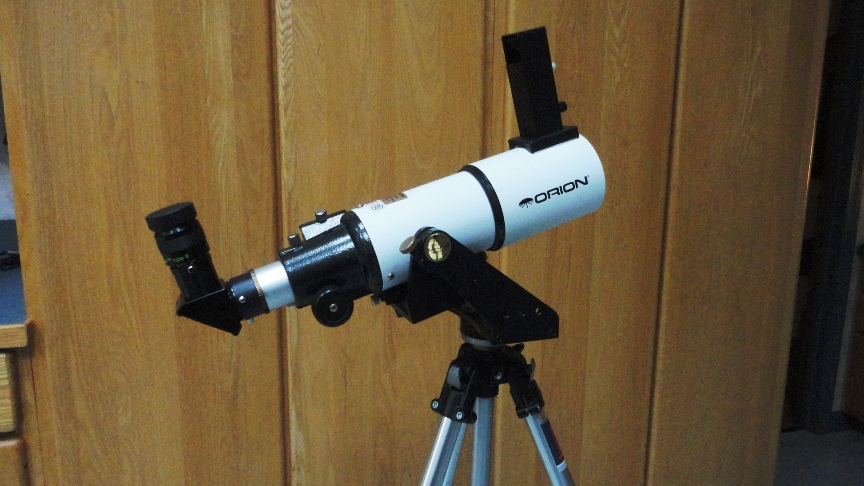
By Ed Ting
Updated 2/16/12
1) Orion Short Tube 80 (2nd review) 1/18/12
2) Takahashi FS-60C (Short Version) 2/14/12
(80 mm f/5 achromat refractor, OTA, $119 retail)
The Orion Short Tube 80 was one of the first telescopes I ever reviewed back in 1997 (has it really been 15 years?!) Back then, I had a version of the scope known as the Celestron FS80WA. I also did a comparo back then with the (sadly discontinued) TeleVue Ranger. The FS80WA has long since disappeared from Celestron's lineup, but the Short Tube 80 seems to have found a permanent home in Orion's catalog. As of this writing, it is available in at least four different versions - as an OTA, as an astronomical equatorial telescope, as a terrestrial spotting scope, and as part of an imaging/guidescope setup (who would have imagined the latter back in 1997?)
I've owned several Short Tube 80s over the years and thought it would be fun to go back and review one of these. The scope remains largely unchanged since its inception. I do notice that newer versions have an internal baffle, and the coatings look different. Otherwise, it's hard to tell that anything has changed. I used the scope mounted alt-az on my TeleVue Telepod/ Bogen 3001 combination. The entire setup can be easily picked up with one hand, making it an ideal grab-and-go scope. I ditched the finder and mounted a Rigel Quik Finder - I'm faster with a red dot finder these days, and the Rigel is lighter than the stock 6X30 unit.

Orion's Short Tube 80 on a TeleVue Telepod, and with Rigel Quik Finder
I had this sample through the fall and early winter of 2011 and took the scope out observing a few times. Other scopes used during this time were the a 12.5" Obsession, the Takahashi FS-60, and several Celestron SCTs - a C5, C6, C8, and C9.25. None of these are really in the niche of the Short Tube 80, but it was nice to have them around for variety's sake. The ST80 exhibits false color - quite a bit of it. Anything brighter than 2nd magnitude showed a ring of purple haze around it. Jupiter was especially prone to chromatic aberration, with that telltale "purple headlight" effect around the planet. In these days of $500 imported apochromats, some may find it hard to put up with the false color in any achromat. The optics showed moderate spherical aberration - the inside/outside diffraction rings are slightly better than the "1/2 wave" diagrams in Suiter's book. Still, for a $100 scope, it isn't bad, and it's certainly better than any typical department store dreck.
We had a few clear, dark nights after the 2011 "Snowtober" storm. Millions of residents lost power in the northeast and the skies were unusually dark. One night, I had no trouble seeing M31, M15, NGC457, Jupiter, M27,M57, M56, Albireo, and other fall showpiece objects.
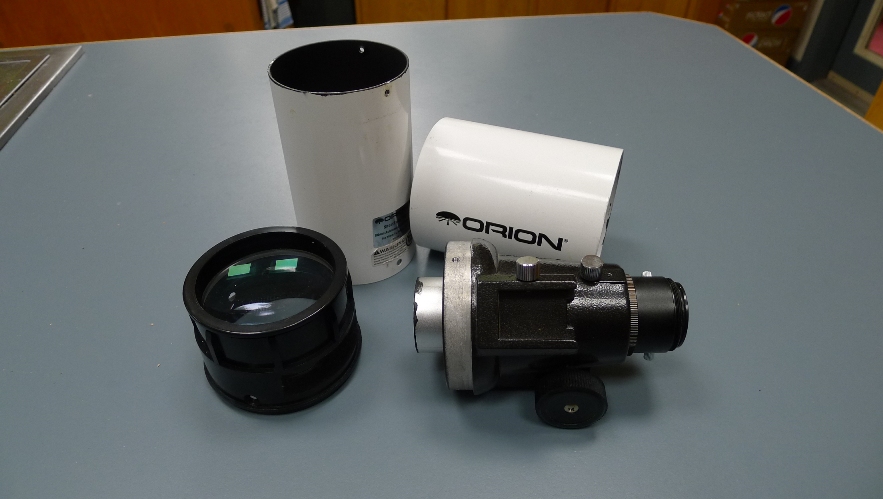
The Short Tube 80, taken apart
And then...and then...
...Well, and then, I got kind of bored. I'd seen everything the scope could show me, and Jupiter was not holding magnification well. At only 57X with the 7 mm Nagler, images were already starting to break down. The closest scope I had on hand was the Takahashi FS-60, which was soaking up magnification like a sponge. Now, the Tak costs ten times what the Short Tube 80 costs, but it does show you there is a difference in quality as you move up the price scale. I took the scope apart, cleaned the optics, did my best to collimate the lens assembly, and put it back together. There was little, if any difference in image quality.
Am I being too hard on the poor Short Tube 80? Maybe. I found I could use it for 20 - 30 minutes before wanting to move on to something else. Usually that "something else" meant the 12.5" Obsession, or the C8. Visually, it's meant as a quick-peek scope, and that's how I used it. Should you get one? Of course! Ownership of one of these seems to be a rite of passage for astronomers. If you're starting out, you need to be aware that the tube needs a good mount (one of Orion's will do just nicely.) Also, if you're a beginner, the ST80 has some serious competition from the Starblast (either the Dob or the equatorial version.) The Starblast gathers a lot more light, has no false color, and wasn't around back in 1997. If I were new to the hobby, I think I'd opt for the Starblast.
So the Orion Short Tube 80 remains what it's always been - a simple, cheap, scope for casual wide field viewing. Hopefully I won't have to wait another 15 years before reviewing one again.
2) Takahashi FS-60C (Short Version) 2/16/12
(60 mm f/5.9 apochromatic refractor, OTA only, ~$1100 street. ~$1700 as reviewed.)
It's been a while since I've owned a nice refractor, so it was good to have one again. The arrival of any Takahashi in your house is a big event, and the FS-60C was no exception. I suddenly found I had a lot of friends. For a few weeks, it seemed like everyone wanted to come by and see it.
I have wanted one of these ever since they came out a few years ago. Takahashi replaced their 60 mm f/8 FC-60 with the new, shorter 60 mm f/5.9 FS-60C. The scope is available in two versions - the standard ("long?") model is called the FS-60SB, and the shorter one, reviewed here is the FS-60CSV. The mechanical construction of the scope is beyond reproach - overkill, as a matter of fact. Although it's the smallest scope currently in their lineup, it's made with the same care as Takahashi's mega-priced telescopes. The white paint job is rich and deep, and the tasteful lime green accents on the cast iron parts enhance any decor. Aesthetics are a personal matter of course, but I think the FS-60C may be the most beautiful telescope I've ever seen. The scope is a real attention-getter. Takahashi telescopes, no matter what the size, are made by people who care, and who expect you to use them, possibly every day.
Before going any further, though, I should get this out of the way. Beginners reading this article should not get one of these. I mention this because whenever I review any telescope, some newcomer runs out and buys one whether they need it or not. The FS-60C does not gather enough light, is quirky to use, and costs way too much. If you're new at this, follow the standard recommendation and get a 6" or 8" Dobsonian reflector from Orion (or one of the other "clones" on the market.) A newcomer to astronomy buying this telescope is like a newly minted teenage driver buying a Porsche.
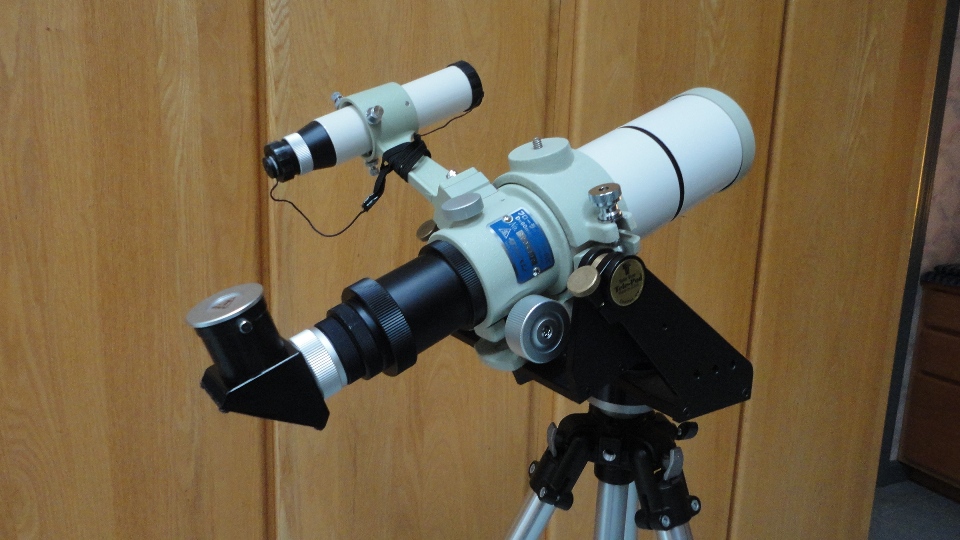
The FS-60C outfitted with 6X30 finder, clamshell ring, and diagonal
As with any Takahashi telescope, none of this comes cheap. Expect to pay close to $1000 just for the optical tube; everything else is extra. The (mandatory) tube clamshell ring is $130, and if you add the 6X30 finder and bracket, they'll set you back an additional $230 or so (but what a finder it is!) You'll also need a diagonal, and a mount of some kind. While you're at it, buy yourself an assortment of extension tubes. All told, if you really want to trick out your new FS-60C, don't be surprised if you wind up spending close to $2000. All of this for a 60 mm refractor!
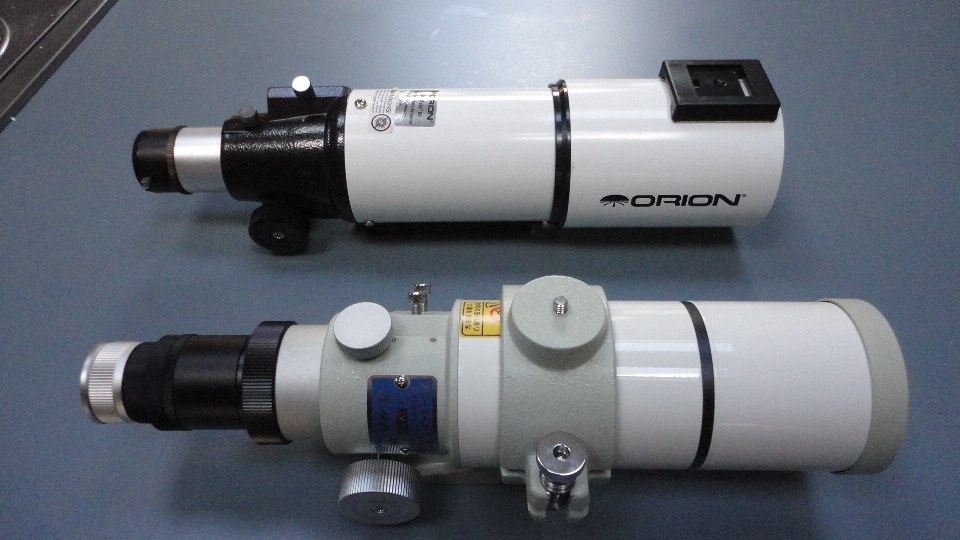
One of these tubes costs $100, and the other one costs $1000
So enough of the hype. How does the scope perform? Like Questars, Takahashi refractors are said to punch way above their weight class, often seeming to perform physics-defying feats. Observing sessions were held with the scope under varying conditions in the winter of 2011/2012. Other scopes nearby included the Orion Short Tube 80 (review above) and an Orion Apex 90. For a change of pace, a 12.5" Obsession and a C9.25 were on hand. As expected, the FS-60C dispensed easily with the Orion Short Tube 80. The ST80's false color and so-so optics got old really fast compared to the little Tak.
Much has been written about Takahashi's focusers. They are buttery-smooth and just seem to work. Other newer refractors have fancier focusers, but to me, nothing beats the simplicity of the Takahashi unit. Having said that, this FS-60C sample had a minor flaw. The focuser has a tiny amount of play in it, and the view "sags" or "hitches" a teeny bit when you release the knob. The tension knob on the top would not correct the problem. Takahashi's instruction manual says nothing about this, and a web search failed to turn up any help. Three of us couldn't figure out how to fix this, and we were afraid to take it apart, so we just left it alone. While an issue like this would be passable in a $100 scope, it's a bit harder to accept in a perfectionist quality telescope like this.
The optics are very mildly overcorrected. Inside of focus there is a tiny magenta coloring. Outside of focus there is a light green coloring, and the diffraction rings are sharper. In focus, however, all traces of color vanish. Like any good refractor, images just "snap" into focus. There is absolutely no doubt when you are at the correct focus position. In contrast, the Apex tended to "ooze" into focus. Jupiter was quite sharp, but with such a short focal length, it's hard to get the magnification up without using barlows.
Which brings up the one issue that kept nagging me about the scope...
The focuser has very little travel in it - only about an inch. Some of the Takahashi focusers have very little travel in them (the FSQ 106 has a similar issue.) Apparently on these imaging-specific scopes, the drawtube must be kept short to avoid cutting off the light cone when racked in. Want to annoy a Takahashi owner? Ask him to barlow the view. He may be able to do it quickly, but sometimes it may take some thought. You wind up "focusing" by adding or taking out extension tubes. The focuser itself thus serves as a kind of "fine focus." Since adding barlows and diagonals can shift the focus position by several inches, you wind up spending a lot of time threading and unthreading those extension tubes. I got used to it over time, but after a while, I started to yearn for a simple, long drawtube.
As you've no doubt concluded by now, Takahashis can be quirky telescopes. The FS-60C I got came with a bag full of parts, some of which I couldn't identify. The manual does come with a system chart, but sometimes there doesn't seem to be any reason to believe it's telling the truth. For example, I can tell you that the visual configuration shown at the top of the diagram (below) will not work. There is not enough out-focus travel.
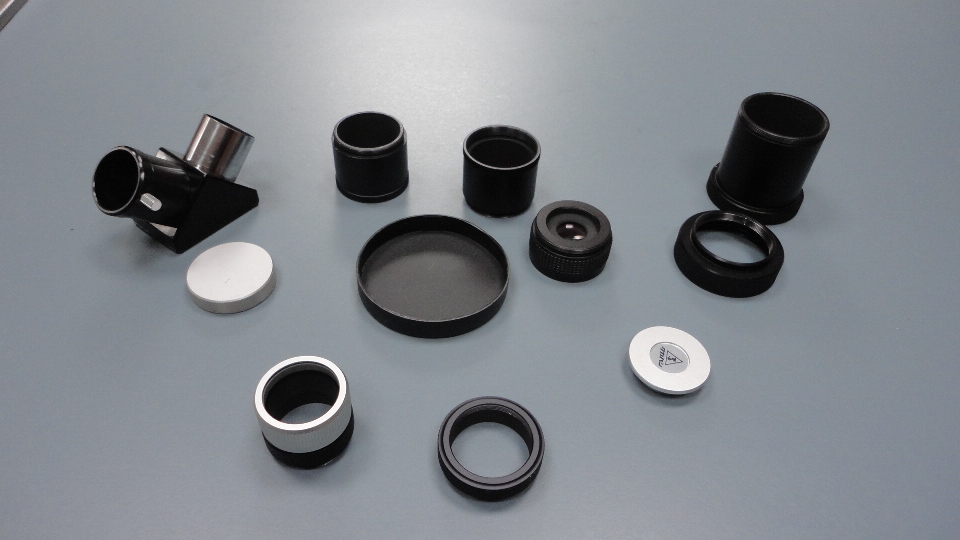
You figure it out! Bag of parts for the FS-60C
Takahashi System Chart for the FS-60C
If you're thinking of getting one of these, here's what I found that worked. For visual use, you need the 57 mm extension tube and a diagonal. For webcam imaging, you need the 57 mm and at least one of the 33 mm extensions. This will bring the camera to focus, as long as you are not using a diagonal. With a barlow in the diagonal, you need at least the 57 mm extension, but some barlows may require only the 33 mm extension. If you are doing visual high power work, a 3 mm - 6 mm Nagler zoom is a tremendous time saver - consider getting one!
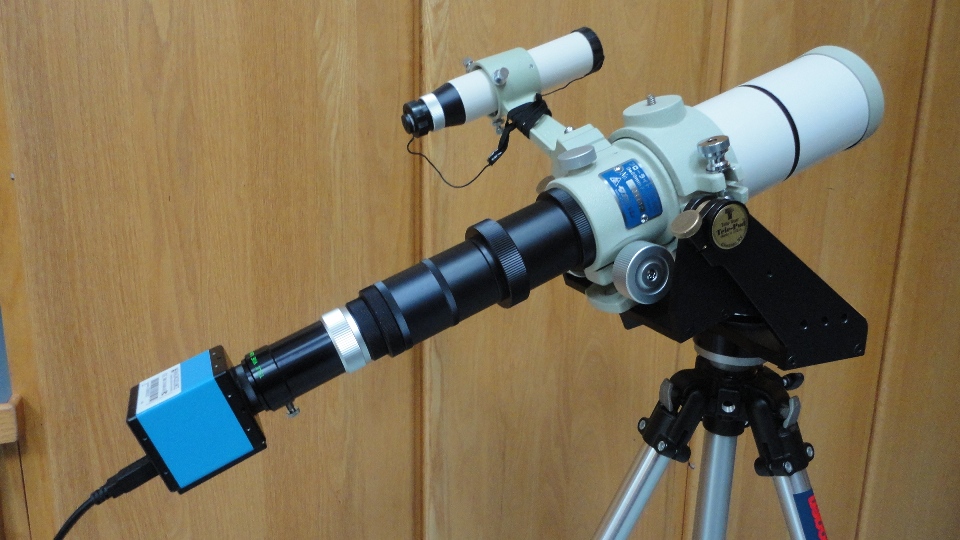
FS60-C set up for webcam imaging - One 57 mm extension, two 33 mm extensions, and a TeleVue barlow
For the next section, I turned the scope over to "Old Dan" S, who's logged over 37,000 observations, including over 7300 double stars.
First night: The scope was used on a TeleVue Telepod, a CG-4, and a CG-5. Eyepieces and barlows were all TeleVues, but I did experiment with the dedicated thread-in Takahashi barlow. The main comparisons were against an Orion Apex 90, an inexpensive 90 mm Maksutov Cassegrain similar to the new version of Celestron's C90.
With a 5 mm TeleVue Nagler, Jupiter was very sharp at 71X. At the same power, Gamma Arietis (4.5, 4.5 mag, 7.5" separation) was cleanly split. Lambda Orionis at 71X was also no problem (3.5, 5.5 mag, 4") and the D member at mag 9.5 was also clearly seen. Gamma Andromedae (2.3, 4.8 mag, 9.8") was also not a problem, and the orange/blue color difference was noticeable. On Jupiter, Ganymede was clearly larger than the other moons.
Polaris (2.1, 9.1 mag, 18") is an interesting challenge. It's not the separation, it's the dimness of the companion that causes you trouble. W.T. Olcott's classic Field Book of the Skies states that a "3-inch telescope, and good atmospheric conditions" will show the companion "but it is not an easy object." The tiny companion is readily detected at the lowest power of the TeleVue zoom (59x at 6mm). With each incremental click of the zoom to the final 3mm setting, the comes becomes easier and easier to see.
Eta Cassiopeiae (3.4, 7.5 mag, 13") - nicely split at all powers of the zoom with the yellow and red colors being subtle.
Castor (1.9, 2.9 mag, 2.1") - 59x, the large white Airy disks show an obvious magnitude variance and have a narrow dark band between them. The next click on the zoom (71x) shows them pleasingly well. The red dwarf tertiary is three-fourths of a magnitude fainter than Polaris's partner but is easier to see due to having four times their separation; however, the dwarf's coloring escapes the tiny Tak.
One issue with using such a small scope to split doubles is the huge size of the airy discs. It's a bit of an optical illusion. The 60 mm scope gives you the impression that it's doing a lot more than it really is. The Apex 90 split these doubles too, but the smaller airy discs looked more point like. The Apex was definitely brighter, but harder to focus - the Tak simply snapped into focus. Also, the contrast was better in the refractor.
With a 19 Panoptic, the Pleiades were nicely framed.
Second night: Even though there was a 9-day moon and flying clouds,
had a pleasant 3.5 hours (8:30 til midnight) with the scope. Primarily did
the double stars in Lynx that are listed in the book Deep-Sky
Observing with Small Telescopes by David Eicher.
Before clouds totally wiped out the sky at midnight, had a look at Gamma Leonis,
aka Algieba, which was beautifully split at 71x (5mm Nagler,
no Barlow).
12 Lyncis, aka Struve 948, is a
quadruple with these values (memo: I did not look for the faint D-member):
AB = 5.4 - 6.0 - 1.9" - 2004
AC = 5.4 - 7.1 - 8.7" - 2004
The AC pair was nicely split at 58x. The AB pair was extremely tight at
97x. This observation had the Tak Barlow installed.
38 Lyncis, aka Struve 1334, is wider that 12 Lyncis but challenging
due to the magnitude variance: 3.9 - 6.1 - 2.6" - 2004. Pushed the
scope to 174x (Tak Barlow and 5mm Nagler). The secondary was difficult
but detectable.
Comments on the Tak Barlow:
1. Personally, I prefer not using it. It adds to the scope's
length which requires rebalancing if not already
attached to a locked down GoTo mount. I have the
CG-5 tripod setup for the C8 and a Starbound
Chair (the chair has a clamp I installed to limit its lowest position) in
order to be in a fairly comfortable position once the scope is near the
zenith. The Tak with Barlow goes below that limit.
2. I wanted to test the scope's focal length with and without the Barlow, but
clouds blocked the star for the test (Delta Orionis, aka Mintaka). Also,
never got around to doing another star test. Got too involved in
observing.
3.The scope runs out of light grasp quickly. For example, Struve 1282 (7.6 - 7.7
- 3.4" - 2000) was split at 71x (5mm Nagler). At 79x, (Tak Barlow and
11mm Nagler), they looked a bit wider but fainter. Ergo, the reason
for testing the scope's focal length. They were well split at 174x (Tak
Barlow + 5mm Nagler) but much dimmer. I also Barlowed
the Barlow (Celestron 2x Ultima
in the normal position of above the diagonal with the Tak Barlow in its normal
position of between the OTA and diagonal) on Struve 958
(6.3 - 6.3 - 4.6" - 2003) with a 20mm eyepiece and the pair was noticeably
dimmer than using the 5mm Nagler by itself (theoretically 71x for each setup).
Summary: I continue to stand by
my earlier comment of using a TeleVue 6mm-3mm zoom for
medium to high powers. For better seeing locations, the TeleVue 4mm- 2mm
zoom with the 5mm or 7mm Naglers. On the low power
side, a 24mm or 19mm Panoptic.
Ed's Comments: Looking at the above, the most impressive of the
observations was the splitting of the AB pair of 12 Lyncis. 1.7" is
way past the Dawes Limit for a 60 mm telescope. The fact that the split
was accomplished at only 79X is remarkable (for reference, try splitting the
pairs of the Double Double in Lyra - which are some 30% wider - with any telescope
at only 80X. Not easy.)
The scope was a lot of fun to use with my Imaging Source webcams.
The focal length is short enough that you can fit the entire 1st quarter moon in the field of view at prime focus:
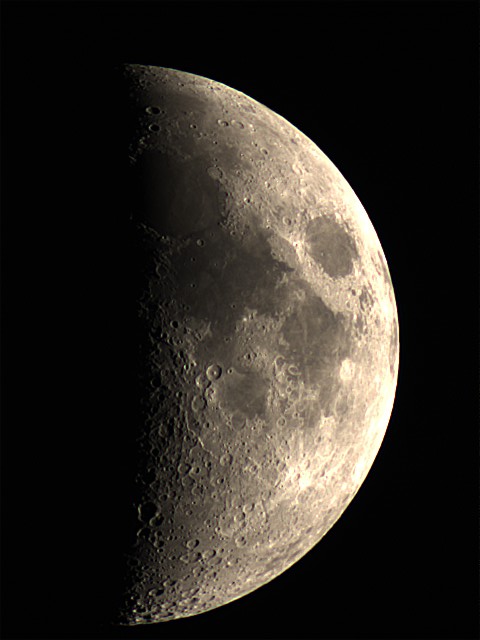
With a 2.5X barlow, it is possible to image Jupiter:
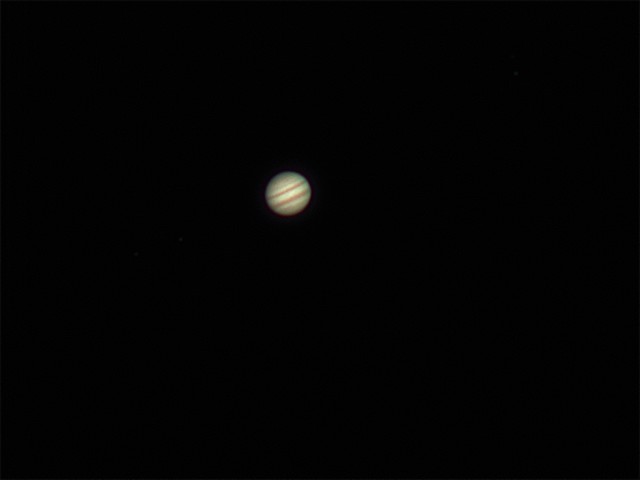
The moon with a 2X barlow:
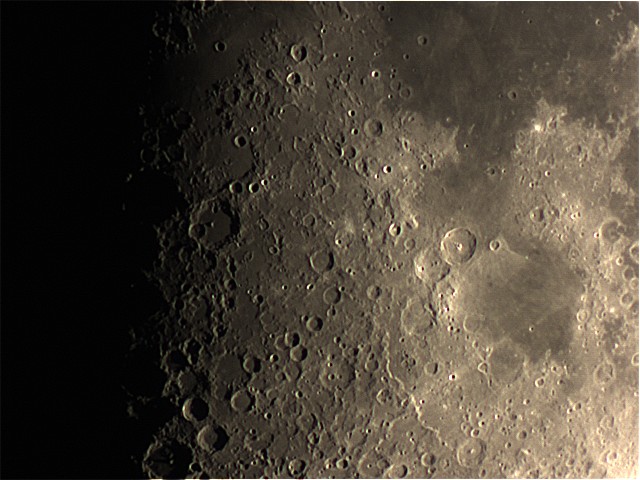
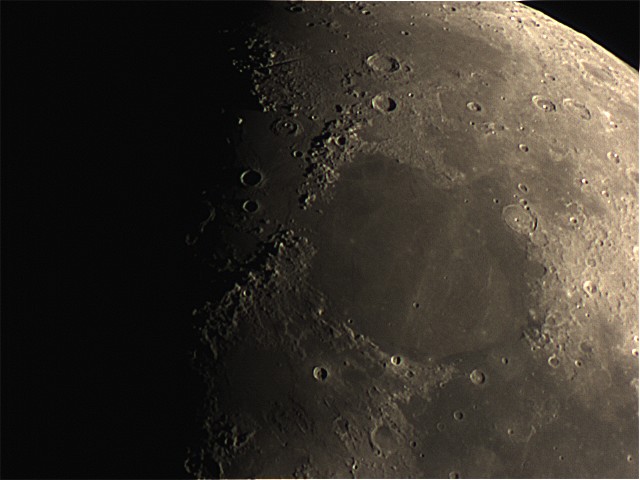
However, images start to break down with a 2X barlow stacked on top of a 2.5X barlow. This simulates the image scale and field of view that you would see at approximately 295X. I think it's a remarkable result for a scope that only gathers 60 mm worth of light.
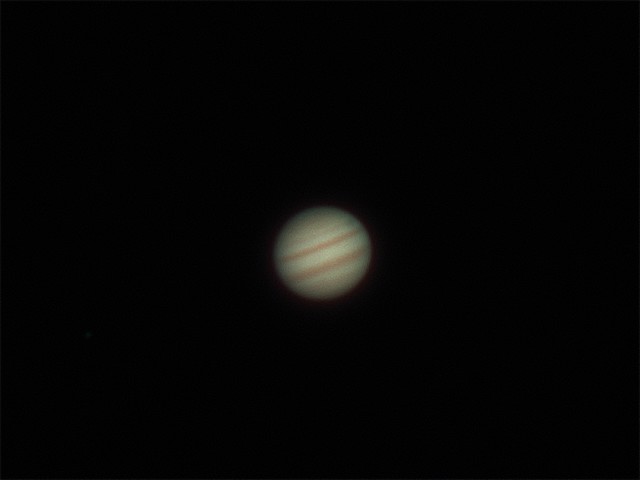
Takahashi FS-60C Hots:
Amazing performance for a 60 mm refractor
Beautiful construction
Will find focus with almost any camera
Takahashi FS-60C Nots:
Expensive
Quirky, finicky extension tube arrangement
Runs out of light quickly
Droopy focuser on review sample
Verdict:
A quirky masterpiece. Takahashi shows that a 60 mm refractor can be a serious telescope. Japanese fanaticism at its finest.
(Note: Many thanks to Dan S for his contributions to this article.)